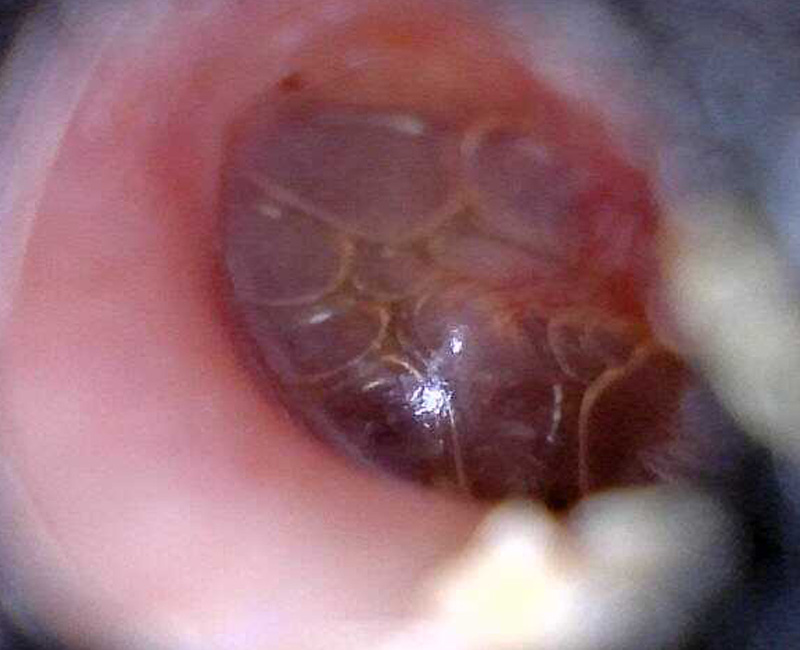Glue ear is a common condition in children that affects their hearing. It makes fluid build up inside their ear, dampening and muffling sound waves passing through their eardrum. You can’t see the fluid yourself, so parents noticing behavior changes and symptoms is usually how pediatricians find it.
Advertisement
Cleveland Clinic is a non-profit academic medical center. Advertising on our site helps support our mission. We do not endorse non-Cleveland Clinic products or services. Policy

Glue ear is a common condition where inflammation makes thick, sticky fluid fill up your middle ear, the space behind your eardrum. This condition can affect one or both ears at a time. It’s a specific subtype of a condition called otitis media with effusion (middle ear inflammation with fluid buildup).
Advertisement
Cleveland Clinic is a non-profit academic medical center. Advertising on our site helps support our mission. We do not endorse non-Cleveland Clinic products or services. Policy
Glue ear usually happens because of an ear infection, but it can happen for other reasons, too. While glue ear is most common in children under 6 years old, anyone can develop it. It’s temporary and usually not serious, but having it long-term can damage your child’s hearing.
The main symptom of glue ear is hearing loss. That’s because fluid buildup inside your child’s middle ear muffles sound waves.
Other symptoms your child might have include:
Younger children and babies may not be able to tell you when they experience symptoms like these. Instead, they may behave differently. Some behaviors you might see include:
Pediatricians often find glue ear after parents notice symptoms or behavior changes and ask for an appointment. It takes a special medical instrument called an otoscope to see the fluid buildup that happens with glue ear.
Advertisement
Ear infections are the most likely cause of glue ear. Your body uses inflammation as part of its immune response to an infection. Inflammation inside your middle ear can narrow or block your eustachian tubes, making it hard for fluid inside to drain out. When the fluid is thicker and stickier, it looks like glue, which is where this condition gets its name.
As fluid builds up, it presses on your eardrum (tympanic membrane). It’s like holding your hand on the head of a drum. Pressure from your hand dampens the vibration, keeping the drum from making as much sound as it should. Likewise, dampening the sound waves as they pass through your eardrum is what muffles sounds in your affected ears.
But inflammation that causes glue ear can also happen for other reasons, including:
Earwax buildup doesn’t cause glue ear. Getting water in your ear while showering or swimming doesn’t cause the condition either.
The main risk factors for glue ear include:
Glue ear can muffle sounds, causing hearing loss in your affected ear. Hearing loss can also make it harder for children to communicate and learn to speak, and may cause a speech delay. They also might have trouble learning and keeping up in school.
Your child’s pediatrician can diagnose glue ear with a combination of methods. The first thing they’ll do is perform a physical exam and ask you about your child’s symptoms.
In some cases, your provider might recommend that your child see an audiologist for further testing. This specialist might run tests like a hearing test or tympanometry.
Most of the time, glue ear goes away on its own without treatment within three months. But depending on what’s causing it and how severe it is, your child’s provider might recommend one or more of the following treatments:
Surgery usually isn’t a first-line treatment. If your child still has glue ear after three months of trying other treatments, your provider may recommend surgery at that point.
Advertisement
You should take your child to their pediatrician if you notice signs that they might have trouble hearing. You should also take them if they have symptoms of an ear infection, especially when the symptoms last longer than two days.
If your child has glue ear, they might not be able to tell you about the symptoms. That makes spotting behavior changes especially important. And it’s important to remember that while it might look like your child is ignoring you or acting out, they can’t help what’s happening to them.
You might be able to use home remedies for glue ear. But it’s best to call your child’s provider and ask them for guidance before trying to treat it yourself. Some remedies you might try include:
You should never use ear candles as a treatment for glue ear. There’s no evidence to support their effectiveness. Worse still, using them can lead to injuries like burns.
You can reduce the odds of your child getting glue ear by making ear infections less likely to develop. Some things you can do include:
Advertisement
Maybe your child has been fussier or more withdrawn lately. Or maybe it takes a few tries to get them to respond when you call them. Young children often can’t tell you their symptoms, so it’s up to you to notice behavior changes that could signal an issue. And glue ear is one condition you might help your pediatrician diagnose if you bring the behavior changes to their attention.
Glue ear usually isn’t serious, especially when caught and treated early. If you have questions about it or think your child might have it, talk to their pediatrician. Glue ear may not need treatment, but knowing what’s happening and what to do about it will help both you and your child as they recover from this condition.
Advertisement
If you have conditions affecting your ears, nose and throat, you want experts you can trust. Cleveland Clinic’s otolaryngology specialists can help.

Last reviewed on 07/28/2025.
Learn more about the Health Library and our editorial process.